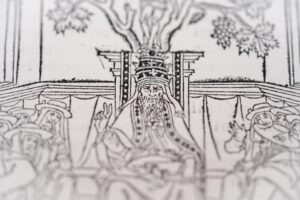It has many names — Shangri-La, Eden, The Land of the Living Gods. To the ancient Tibetans, the spiritual kingdom of Shambhala was an ultimate goal. In Buddhism, this city hidden deep underground beneath the Himalaya is a place of pure enlightenment, knowledge, and peace, free of all evil. Utopia. People from different walks of life have searched for this paradise, from esoteric New Agers to even Nazis at one point.
Background
Shambhala appears in both Buddhist and Hindu texts. Buddhism and Hinduism often overlap, thus sharing the same legend. These texts, specifically the Kalachakra tantra, the Mahabharata, and Vishnu Purana depict it as an Earthly paradise or a place where gods dwell. The Sanskrit name means “place of tranquility.”
Legend states that only those pure of heart and soul and fully enlightened can enter it. Those who live there acquire vast knowledge, complete happiness, and most importantly, immortality. The kingdom is hidden from the outside world by eight mountain ranges.
According to one origin story, Shambhala began when a king named Manjuśrīkīrti in 159 BC attempted to convert many from sun worship to a type of Buddhism. Those who didn’t were expelled. Some of those founded Shambhala.
According to both Buddhism and Hinduism, Shambhala foretells the return of an ancient Tibetan hero called Gesar of Ling as well as the reign of the final incarnation of Vishnu. They will bring forth a new age of peace and wisdom. This will supposedly take place in 2424-2425.
Physical or metaphorical?
Depending on the source, Shambhala takes on many different guises. Some say it is a physical place in the mountains, requiring dangerous travel and many physical and spiritual obstacles. Others say it lies underground deep within a hollow Earth. Some scholars believe it is simply symbolic or allegorical. The legend of Shambhala was the basis of James Hilton’s fictionalized account of Shangri-La, in his book Lost Horizon.
Author and mountaineer Edwin Berbacum referred to it as “an illusory inner sanctuary…to escape the unpleasant realities of the world.” Esoteric writer Alice Bailey believed it resided on another plane of existence entirely. There are varying descriptions of it, either as part of the world in which we live or not of our world at all.
The search
Jesuit missionaries tried to find it in the 1600s. In the 1800s, Helena Blavatsky, the founder of the mystic Theosophy sect, claimed she spoke to Shambhala’s kings telepathically.
Most famously, the prospect of finding a supernatural realm of powerful gods and endless knowledge tickled the fancies of both the Nazis and Soviets. Hitler’s fascination with the occult and New Age beliefs prompted Heinrich Himmler to create a special task force called the Bureau of Ancestral Heritage, or the Ahnenerbe in German. It researched ancient cultures to help justify Hitler’s cause and to use for propaganda. Himmler even funded an expedition to Tibet to search for Shambhala.

A monk and statues of Buddha. Photo: SantiPhotoSS/Shutterstock
Meanwhile, the Soviets wished to access powers beyond the human world to control and crush their enemies. They believed that this utopia and the ideals of communism were sympathetic.
This is where a couple named Nicholas and Helena Roerich play a major role. They were theosophists and believed in Blavatsky’s movement, which merged Jewish, Christian, Buddhist, and Hindu beliefs. They embarked on an expedition to Tibet in the 1920s, passing over 30 mountain passes.
“Great Shambhala is far beyond the ocean. It is the mighty heavenly domain. It has nothing to do with our Earth,” Nicholas Roerich quotes a lama in his book.
This did not make them turn back. At one point, the party mysteriously disappeared for a time but made it out in one piece. They briefly mentioned that they had found the door to Shambhala, blocked up with stones.
A modern quest
Writer Patrick Symmes of Outside magazine attempted to find it himself. Studying 14th to 16th-century texts, he believed that Shambhala involved traveling 5,471km through mountain passes, deserts, unchartered roads, and other dangerous paths. He found no Shambhala. Instead, he came across people who made fun of him for even attempting such an expedition.
Archaeologists and historians think that if it does exist, it is somewhere in western China, between Tibet and Kashmir or the Sutlej Valley. However, no expedition has found any trace, including archaeological evidence. There is a city called Shangri-La in China that is associated with Shambhala but that is about marketing and tourism.
The takeaway
Every culture has a concept of Heaven or a place of peace. Shambhala is one of its many incarnations. It is the classic story of trying to achieve the unobtainable: perfection. Perfection is impossible. The crazy and dangerous region in which it hides symbolizes the obstacles we must face to reach that goal. If anything, Shambhala sounds like an allegory of this human experience.






